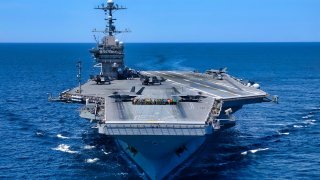Nimitz-Class Navy Aircraft Carrier George Washington Is Headed Everywhere
The USS George Washington (CVN-73), a Nimitz-class supercarrier of the United States Navy, has embarked on a significant deployment from Naval Station Norfolk, Virginia.
Summary: The USS George Washington (CVN-73), a Nimitz-class supercarrier of the United States Navy, has embarked on a significant deployment from Naval Station Norfolk, Virginia.
-The carrier is set to operate in the United States Southern Command area of operations as part of the Southern Seas 2024 exercise, making stops in South American countries including Brazil, Chile, and Peru.
-This deployment serves as a precursor to its role as the forward-deployed naval forces (FDNF) aircraft carrier in Japan, replacing the USS Ronald Reagan (CVN-76). The USS George Washington has recently completed a prolonged midlife nuclear refueling and complex overhaul, which was extended due to various challenges including the COVID-19 pandemic. This deployment marks the vessel’s return to action and is aimed at enhancing interoperability and building maritime partnerships in the region.
USS George Washington Sets Sail for Southern Seas 2024 Before Japan Deployment
The United States Navy's Nimitz class supercarrier USS George Washington (CVN-73) has departed Naval Station Norfolk, Virginia, and will begin her deployment to the United States Southern Command area of operations as part of the Southern Seas 2024 before heading to Japan.
CVN-73 will relieve her sister ship USS Ronald Reagan (CVN-76) as the forward-deployed naval forces (FDNF) aircraft carrier.
This will be the second time that USS George Washington has served as the FDNF aircraft carrier – and in 2008, it became the first nuclear-powered flattop to be forward-deployed to Japan. The USS Ronald Reagan will return to the U.S. for an overhaul, but it should be noted that overseas deployments of American naval ships are limited to 10 years under U.S. law.
CVN-76 relieved the USS George Washington in 2015.
USS George Washington: First Stop South America!
The crew of the USS George Washington will have plenty of time to hone their Japanese language skills and may want to get out the Portuguese and Spanish phrase books first. The nuclear-powered warship will sail through the Pacific after rounding Cape Horn at the southern tip of South America – and is expected to make port calls in Brazil, Chile, and Peru.
During the voyage, it will operate with several Latin American navies including those of Argentina, Brazil, Chile, Colombia, Ecuador, Peru, and Uruguay.
The Nimitz-class aircraft carrier will be part of the U.S. 4th Fleet's Southern Seas 2024 event that will team Washington up with the Arleigh Burke guided-missile destroyer USS Porter (DDG 78), and Henry J. Kaiser-class replenishment oiler USNS John Lenthall (T-AO-189). The carrier will embark with a partial air wing from Carrier Air Wing 7, Naval Air Force Atlantic announced.
"Southern Seas 2024 will provide the opportunity to improve interoperability and increase proficiency with partner nation maritime forces," said Rear Adm. Jim Aiken, Commander U.S. Naval Forces Southern Command/U.S. 4th Fleet. "Deployments like Southern Seas strengthen maritime partnerships and build trust with our partners in the region."
Back in Action – Better Late Than Never
This is the first deployment for the USS George Washington since she completed her midlife nuclear refueling and complex overhaul (RCOH) at HII's Newport News Shipbuilding in Virginia.
The normally four-year-long maintenance period stretched to just short of six years due to a number of factors, including supply chain issues and workforce problems that were exacerbated by the COVID-19 pandemic, USNI News reported. USS George Washington began the RCOH period on Aug. 4, 2017, and was only redelivered to the U.S. Navy on May 25, 2023.
During the RCOH, the sea service also conducted an extensive quality of life study that revealed sailors living aboard the carrier had some of the toughest living conditions in the Department of Defense (DoD). The investigation followed the death by suicide of nine of the carrier's sailors from 2017 to 2022.
Author Experience and Expertise: Peter Suciu
Peter Suciu is a Michigan-based writer. He has contributed to more than four dozen magazines, newspapers, and websites with over 3,200 published pieces over a twenty-year career in journalism. He regularly writes about military hardware, firearms history, cybersecurity, politics, and international affairs. Peter is also a Contributing Writer for Forbes and Clearance Jobs. You can follow him on Twitter: @PeterSuciu. You can email the author: [email protected].


